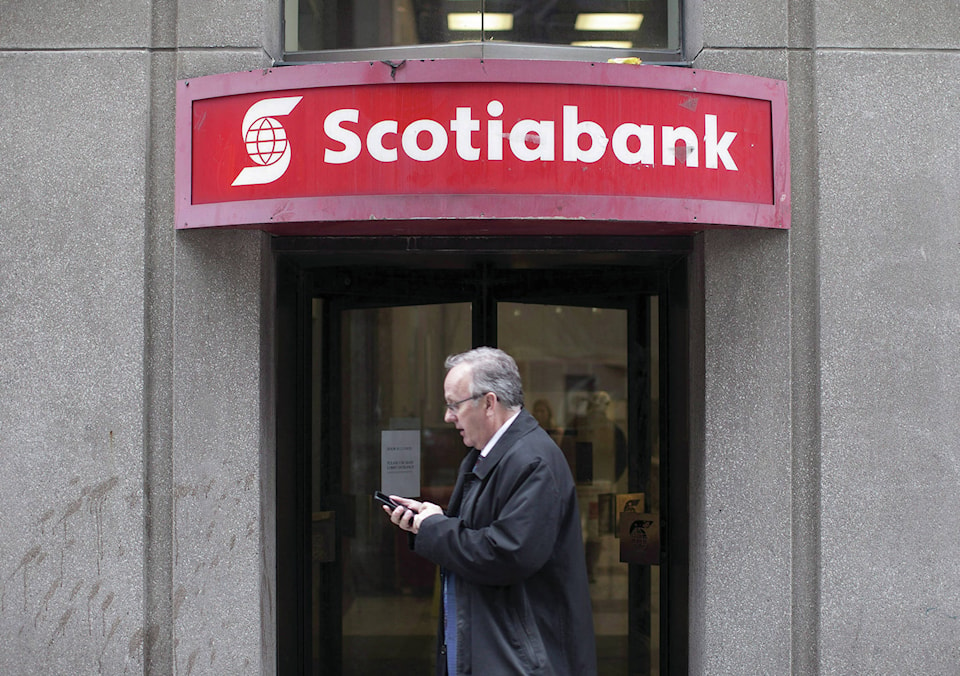TORONTO — The Bank of Nova Scotia’s footprint in Latin America fuelled its third-quarter earnings to beat market expectations while its rival BMO Financial Group missed the mark amid higher loan loss provisions and slower growth in Canada and the U.S.
Scotiabank, which has the largest international presence among Canada’s Big Six Banks, raised its dividend Tuesday as the lender reported a 2.3-per-cent increase in quarterly profits to $1.98 billion.
The lender’s strategy of focusing on the Pacific Alliance countries of Chile, Colombia, Mexico and Peru paid off during the latest quarter, with its international banking division delivering double-digit earnings growth.
Although earnings outside Canada’s borders was offset by acquisition and divestiture related costs and lower profits in global banking and markets, Scotiabank beat analyst estimates on Tuesday for the first time after four consecutive misses.
“We are pleased with this quarter’s results, which represent a marked improvement from results earlier in the year,” Scotiabank’s chief executive Brian Porter told analysts. “We delivered strong EPS growth. Our recent acquisitions are contributing ahead of expectations, and we made significant progress towards our geographic repositioning while building capital and improving our risk profile.”
Based on these results, Canada’s third-largest bank said it will raise its quarterly payment to shareholders by three cents to 90 cents per share.
On an adjusted basis to exclude items such as a $402-million loss related to the divestiture of its business in Puerto Rico, the Toronto-based lender said it earned $2.46 billion or $1.88 per diluted share during the quarter ended July 31.
That’s up from $2.26 billion or $1.76 per share during the same period in 2018. Analysts had expected an adjusted profit of $1.85 per diluted share, according to the financial markets data firm Refinitiv.
Scotiabank’s provision for credit losses, or money set aside for bad loans, totalled $713 million in the quarter, down from $943 million during the same period a year earlier.
Its rival BMO, however, reported a notable jump in loan loss provisions which largely drove its earnings to miss analyst expectations.
BMO’s provisions for credit losses totalled $306 million during the quarter, up from $186 million in the prior year.
The bank’s chief risk officer, Patrick Cronin, said the increase in provisions for credit losses was driven by higher Canadian consumer losses, “almost entirely as a result of implementation issues with a new consumer collections platform” as well as a large loss in its Canadian commercial portfolio and a higher provision for performing loans.
Canada’s fourth-largest bank saw growth in its capital markets division but lower earnings in wealth management, due to lower insurance revenue.
Meanwhile, BMO’s Canadian and U.S. personal and commercial banking arms each posted slower growth of roughly one per cent, to $648 million and $368 million, respectively. The modest growth south of the border comes as BMO has been pushing to grow its U.S. business and the proportion of earnings it generates south of the border.
BMO chief executive Darryl White said it is hard to ignore that trade tensions are creating volatility in markets and “some suppression of growth.”
“Our customer base in Canada and the U.S. continues to spend and continues to expand, I would say, a little more prudently than perhaps they might have six or 12 months ago,” he told analysts Tuesday. “So a slowing environment as a result of the trade measures for sure. As far as credit is concerned, we do feel it in some portfolios more than others.”
Cronin said BMO is “not seeing any concerning systemic thematic or sectoral trends in any of our credit books, which remain a strong and consistent quality.”
Credit quality amid recession fears and the impact of increasing trade tensions between the U.S. and China have been closely watched factors during this round of quarterly bank earnings, which has been a mixed bag.
Last week, the Royal Bank of Canada’s quarterly profits rose but fell short of expectations on lower capital markets earnings amid challenging conditions. The Canadian Imperial Bank of Commerce beat analyst estimates on surprise growth at home in personal and small business banking and in its U.S. commercial banking platform that was counteracted by weaker capital markets and a rise in loan loss provisions.
Both RBC and CIBC reported an increase in provisions for credit losses in the latest quarter, but both lenders’ executives said they were comfortable with the outlook.
BMO’s miss on higher provisions prompted investor concern on Tuesday as its shares on the Toronto Stock Exchange slipped by more than four per cent to $88.55 in midday trading.
“It does not look like there is anything systemic in the credit numbers, but this will likely be a focal point in the market… BMO did make some progress on its costs controls and its lending growth remains strong but may not be enough to dampen the negative perception of headline earnings,” said John Aiken, an analyst with Barclays in a note to clients.
Meanwhile, Scotiabank’s shares were up by roughly one per cent to $68.45 in midday trading in Toronto.
“After four consecutive misses on earnings, we are encouraged by BNS’s (third-quarter) results,” said Scott Chan, an analyst with Canaccord Genuity in a note to clients. “We believe BNS shares should relatively outperform peers.”
